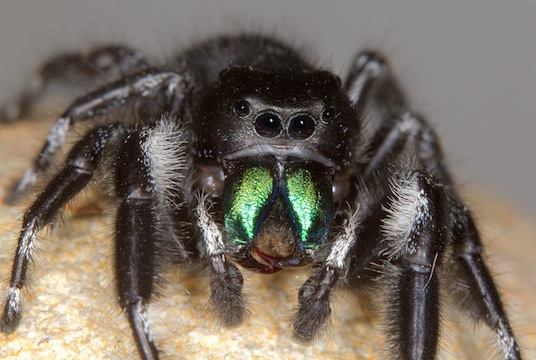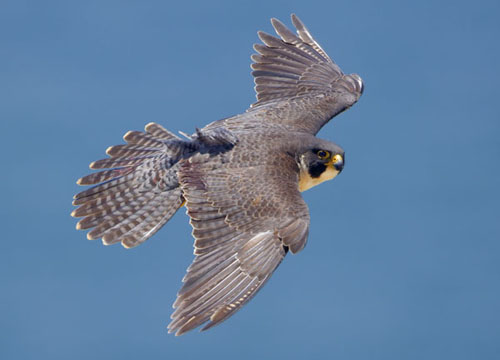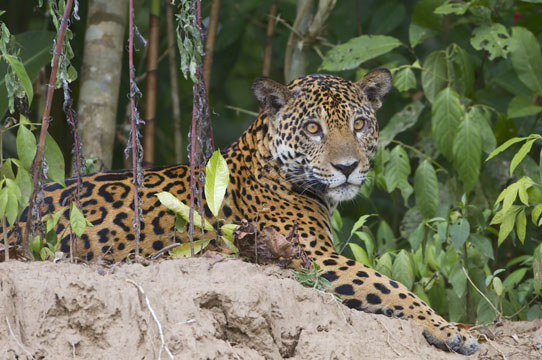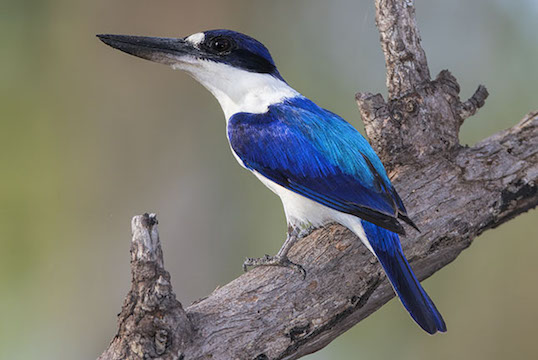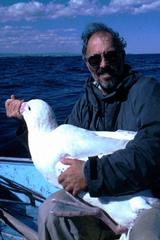
MARK CHAPPELL
Professor of Biology
Office: 2312 Spieth Hall (Biology)
Office phone: 951-827-7709
Lab phone: 951-827-6418
Facsimile: 951-827-4286
E-mail: mark.chappell@ucr.edu
Degree: Ph.D., Stanford University, 1977
profile in Google Scholar Citations
My laboratory studies animal physiological ecology, with emphasis on
adaptations to extreme environmental conditions (particularly in desert, polar,
and montane habitats),
energetics and behavior of free-living animals, evolutionary physiology (particularly
of aerobic traits), and behavioral
ecology (particularly reproductive effort and signal costs). I use
techniques from mainstream physiology, but am interested in evolutionary
and ecological questions as well as organismal form and function per
se. My students and I participate in both the Evolutionary
Biology and the Physiology
graduate groups. In addition, I participate in the University of California
Intercampus
Research
Program
on Experimental Evolution (UCIRPEE) and its successor, the Network for Experimental Research on Evolution (NERE). Some of the things the lab has worked on over the years include:
- Foraging behavior (abstract)
and reproductive energetics (abstract)
of Adélie
penguins.
- Repeatability (individual consistency) of aerobic performance in ground
squirrels and red junglefowl (abstract)
- Energetics of metamorphosis in holometabolous insects (such as sphinx
moths)
- The energy metabolism of daily torpor in hummingbirds (abstract)
- Accommodation of changing oxygen demand by the ventilatory system in
birds and mammals (abstract)
- Energy costs and signal honesty in avian vocal signals, such as courtship
calling and begging by chicks (abstract)
- Evolutionary physiology (especially exercise performance) and physiological plasticity in altitude adaptation in deer mice (abstract
1, abstract
2, abstract 3, abstract 4, abstract 5, abstract 6) and other rodents ( abstract 7)
- Functional analyses of individual variation of aerobic performance
in birds (abstract)
Current and fairly recent projects include:
- Physiological, behavioral, and ecological factors in altitude distribution limits of Northern Andean birds (click here for an overview of a recently-completed collaborative project in Peru; other work is ongoing in Colombia)
- Limits to aerobic capacity in mammals and birds: phylogenetic effects and mechanistic underpinnings
- Behavior and costs of transport during voluntary locomotion in small mammals
Please note that I am not accepting new graduate students at this time. If you are interested in doing graduate research as part of the Neotropical bird ecology project, I encourage you to consider working with my colleague Scott Robinson at the Florida Museum of Natural History, or Gustavo Londono at Universidad Icesi in Cali, Colombia.
Some Representative Publications....
- Chappell MA, Buttemer WA, Russell AF (2016). Energetics of communal roosting in Chestnut-crowned Babblers: Implications for group dynamics and breeding phenology Journal of Experimental Biology 219: 3321-3328
- Londono GA, Chappell MA, Jankowski JE, Robinson SK (2016). Do regulatory costs limit the altitude distributions of Andean forest birds? Functional Ecology 31: 204-215
- Bech M, Chappell MA, Astheimer LB, Londono GA, Buttemer WA (2016). A 'slow pace of life' in Australian old-endemic passerine birds is not accompanied by low basal metabolic rates. Journal of Comparative Physiology B 186: 503-512
- Londono, GA, Chappell MA, Castenada M, Jankowski JE, Robinson SK (2015). Basal metabolism in tropical birds: Latitude, altitude, and the 'pace of life'. Functional Ecology 29: 338-346
- Oufiero CE, Meredith RW, Jugo KN, Tran P, Chappell MA, Springer MS, Reznick DN,Garland T (2014). The evolution of the sexually selected sword in Xiphophorus does not compromise aerobic locomotor performance. Evolution 68: 1806-1823
- Dlugosz EM, Chappell MA, Meek TH, Szafranska PA, Zub K, Konarzewski M, Jones JH, Bicudo E, Nespolo RF, Careau V, Garland T (2013). Phylogenetic analysis of mammalian maximal oxygen consumption during exercise. Journal of Experimental Biology 216: 4712-4721
- Chappell MA, Szafranska PA, Zub K, Konarzewski M (2012). The energy cost of voluntary running in weasels, Mustela nivalis. Journal of Experimental Biology 216: 578-576.
- Chappell MA, Savard JF, Siani J, Coleman SW, Keagy J, Borgia G (2011). Aerobic capacity in wild satin bowerbirds: repeatability and effects of age, sex, and condition. Journal of Experimental Biology 214: 3186-3196.
- Chappell MA, Bailey NW, Redak RA, Antolin M, Zuk M (2009). Metabolic similarity despite striking behavioral divergence: Aerobic performance in low- and high-density forms of the Mormon cricket. Physiological and Biochemical Zoology 82: 405-418.
- Chappell MA, Dlugosz EM (2009). Aerobic capacity and running performance across a 1.6 km altitude difference in two sciurid rodents. Journal of Experimental Biology 212: 610-619.
- Wiersma P, Chappell MA, Williams JB (2007). Cold- and exercise-induced peak metabolic rates in tropical birds. Proceedings of the National Academy of Sciences (USA)104: 20866-20871.
- Chappell MA, Garland T, Rezende EL, Gomes FR (2004). Voluntary running in deer mice: speed, distance, energy costs, and temperature effects. Journal of Experimental Biology 207: 3839-3854.
- Chappell MA, Bech C, Buttemer WA (1999) The relationship of central
and peripheral organ masses to aerobic performance variation in House Sparrows.
Journal of Experimental Biology 202:2269-2279.
- Bachman GC, Chappell MA (1998) The energetic cost of begging behaviour
in nestling House Wrens. Animal Behaviour 55:1607-1618.
- Chappell MA, Zuk M, Johnsen TS, Kwan TH (1997) Mate choice and aerobic
capacity in red junglefowl. Behaviour 134:511-529.
- Chappell MA, Janes DN, Shoemaker VH, Bucher TL, Maloney SK (1993).
Reproductive effort in Adélie Penguins. Behavioral Ecology and Sociobiology
33:173-182.
(click here
for a complete publication list)
Recent Teaching....
- Biology 5B, Introduction to Organismal Biology
- Biology 160, Animal Behavior
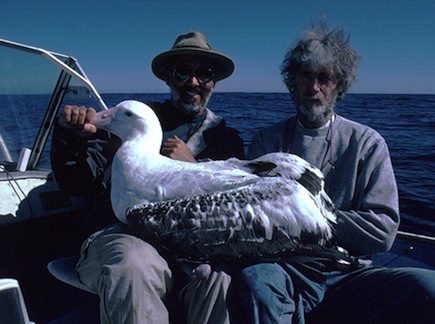
Adult wandering albatross (Diomedia exulans or D. gibsoni*)
captured for metabolic studies off Wollongong on the south-east coast
of Australia. The birds were banded and released unharmed within 2-3
days; they were remarkably placid in captivity. Wanderers have the
longest wingspan of any living bird (more than 3 meters and sometimes as
much as 3.6 meters). Some individuals in this population were first
banded in the late 1950s and continue to return to the Wollongong area every
winter. A few are known to be over 50 years old -- the very white male in the photo at the top of this page is one of these.
I'm the one with the hat; the other nonflying terrestrial vertebrate
in the photo is Harry Battam from the University of Wollongong, a world
authority on albatross biology.
* the taxonomy of albatrosses is currently undergoing
revision



